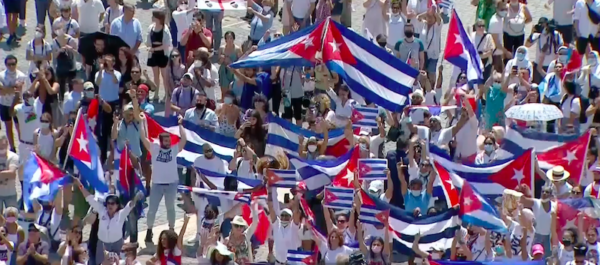‘I Felt Like I Was Back in Cuba’
By Inés San Martín
ROME (Crux) — Many were shocked on Sunday when the Vatican police forced a group of 15 Cuban demonstrators to put down their Cuban flags at the Sunday Angelus in St. Peter’s Square.
Although political manifestations have always been banned at the event, pilgrims often bring flags, hoping Pope Francis will make mention of their country.
On Sunday, at least one young Cuban refused to give up his flag, instead kneeling down in the square. Videos available on social media show a Vatican policeman grabbing the flag. A woman, Amor de Grecia Rodriguez, who was doing a Facebook live video during the Angelus, had her flag around her neck, as a cape, and the same officer took it from her.
When she asked to have her flag back, he refused. When several voices were heard telling the Vatican police that no one can be forcibly removed from God’s house, the man, wearing sunglasses, said that they are not being removed, and argued that he had asked them several times to put down the flags.
Around them, the national emblems of Peru, Honduras, Spain, and other countries can be seen.
Why were the Cubans in St. Peter’s Square?
Rome is home to a large community of Cuban expatriates, most of whom fled the oppression of the Communist regime that has ruled over the island nation since Fidel Castro’s 1959 revolution.
Since July 11, after a series of protests on the island, the Cubans have been present at public papal events, particularly the weekly Wednesday audiences and the Sunday Angelus prayer.
In the beginning, their strategy of trying to garner Pope Francis’ attention so that he would speak about what’s happening seemed to work: On Sunday, July 18, Pope Francis expressed his closeness to Cuba, and voiced the hope that the country will become more just and fraternal.
The Cubans who live in Rome know — and abide by — the Vatican’s rules: no political statements are allowed. But the flags have always had a green light. On Sunday, that changed.

“I felt like I was back in Cuba,” Amor de Grecia Rodriguez told Crux on Monday. “We’ve gone to papal events many, many times, and we know that political slogans are not allowed. And we’re fine with that.”
“We believe that God knows of the suffering of the Cuban people,” she said. “We don’t need to go to the Vatican or a church for him to know about it. But we are tired of the blind, deaf, and mute who refuse to see, hear and speak about what’s happening to our people.”
Rodriguez acknowledged that Pope Francis cannot fix the problems of Cuba.
“But we wanted him to give us a minute of his time, so that he once again raised his voice against the dictatorship. He’s a public figure, of world relevance, and as such, he can have an influence,” she said.
“We were treated like dogs,” she said, adding that, much like Pontius Pilate, the Argentine pontiff had washed his hands of the suffering of Cuba.
Why did the Vatican police act on Sunday?
Cuban-American actor and political activist Alexander Otaola had summoned his followers to gather in St. Peter’s Square on Sunday, and some 500 people from all around Europe were set to answer his call.
In a live transmission on Facebook this Saturday, Otaola claimed that the police had told them they would be allowed into St. Peter’s Square, while informing his followers that demonstrations inside the Vatican are forbidden. Following this warning, he urged them to “meet there as pilgrims, as religious, as people of faith, as people who come advocating for the needy, who come advocating for the people who are oppressed.”
He also stated that the reason he was going to attend was for Pope Francis to take “a stance against the Cuban dictatorship.”
“The Pope has to speak, he has to manifest himself, and as head of a state he has to take a position before the suffering, before the repression, before the calamity, the fear, the harassment that the Cuban people are suffering,” Otaola said.
However, on Sunday morning, the message spread across Cuban exile WhatsApp groups that they weren’t going to be allowed in St. Peter’s Square. For this reason, only 15 people were able to get into the square, including people like Rodriguez, who told the guards that she came from Rome and was an Italian citizen, things she knew she could attest with her ID.
The Vatican police officer who took her flag reportedly told her to think of herself as “fortunate” for being there, to which she told Crux: “I wasn’t ‘fortunate,’ I was only able to get into the square because I don’t fit their norm of what a Cuban looks like — brown skin and black hair.”
Otaola and others placed themselves on the Via della Conciliazione that leads to St. Peter’s and laid down, covering themselves with the Cuban flag and carrying signs with religious connotations, such as “mercy for the Cuban people.”
Another of the Cuban regulars, who was present on Sunday and has attended public papal events, told Crux that they feel “trapped between a sword and a wall,” because “everything is a little — or a lot — more complicated than what it looks like.”
Asking to remain anonymous because of their standing within the expat community, the Cuban group argued that their treatment by police in the square was unfair — “violent even.” They also said that it’s true that most of the “regulars” go to St. Peter’s for religious reasons. However, there’s also an intrinsic political undertone in their presence because “we’re not only asking the pope to intervene in our favor with God, but also with a Communist regime that is killing us.”
The person said to pretend that the planned manifestation on Sunday “would not have been a political statement [in] itself would be disingenuous.”
